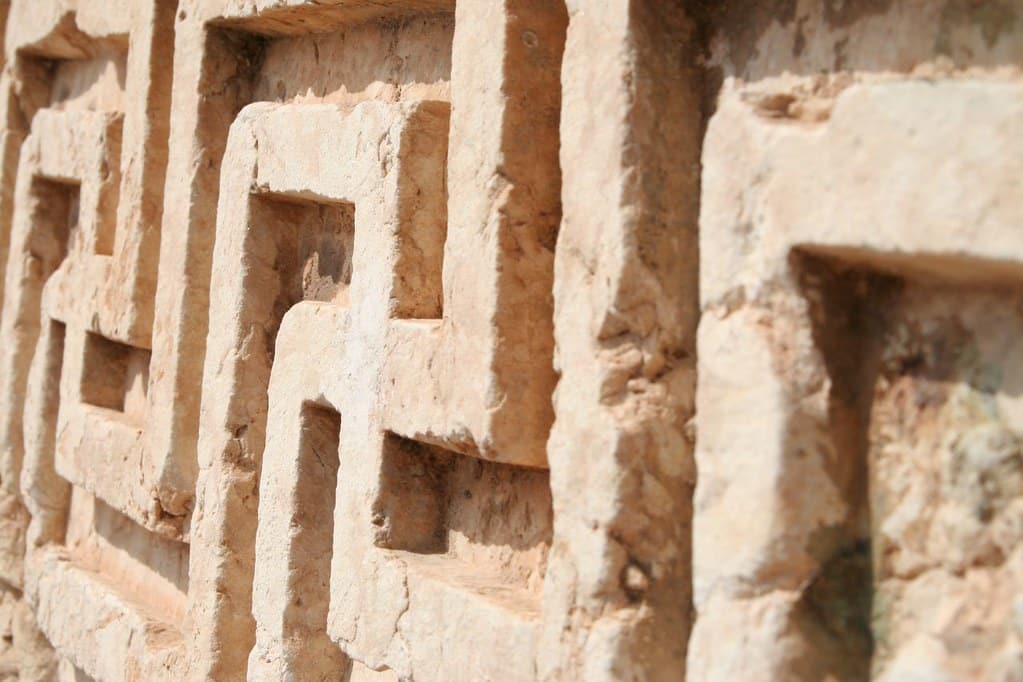
Today, the swastika symbol comes attached to the imagery of Nazi Germany and the holocaust, but the origins of this four-armed symbol predate the Third Reich by at least 8,000 years. It was even used by the ancient Greeks and Egyptians, Romans, Etruscans, and Phoenicians. Even today, it holds spiritual importance in Hinduism. The word swastika comes from Sanskrit: स्वस्तिक (svastika) meaning ‘conducive to well-being’.
Early swastikas
The earliest known swastika forms part of an intricate meander pattern of joined-up swastikas found on a late palaeolithic figurine of a bird, carved from mammoth ivory, which was discovered in Mezine in modern-day Ukraine. Researchers have posited that this particular swastika may be a ‘surrealist’ picture of a stork in flight, and as the item was found near a number of phallic objects, it has also been theorized that the pattern was a symbol of fertility.

Later swastikas were found in the Iranian mountains, inscribed on stone walls, estimated to be more than 7,000 years old. One was discovered in modern-day Khorashad, Birjand on the holy wall Lakh Mazar.
Ceramic pottery in the Devetashka cave in Bulgaria, dated back to 6,000 BC, has also featured the symbol, although in a mirrored form. Further east, some of the earliest archaeological evidence of the swastika on the Indian subcontinent has been dated back to around 3,000 BC, with some researchers hypothesizing that the symbol came to Western and African societies from this part of the world.
A Symbol of Spirituality and Good Luck
In ancient societies (and even today in some eastern cultures), the swastika was considered a symbol of divinity and spirituality. In fact, the word comes from Sanskrit and translates as “conducive to well-being.” Hinduism holds that the right-facing swastika (clockwise) symbolizes ‘surya’ or ‘sun,’ bestowing prosperity and good luck, while the left-facing anti-clockwise symbol (sauvastika) symbolizes night or tantric aspects of the Hindu goddess Kali.
In the Jain tradition, it represents Suparshvanatha, the seventh of 24 Tirthanakaras (spiritual teachers and saviors), and, in Buddhist interpretation, it denotes the footprints of the Buddha.
Ancient Greek use of the swastika
Ancient Greek use of the swastika symbol (pre-Etruscan) may date back as far as the ancient city of Troy (founded around 3,000 BC), which was located along the northwest coast of Asia Minor in modern-day Turkey.
In his late-nineteenth century excavations around the Dardanelles, Heinrich Schliemann found objects decorated with swastikas. When news reached him of this discovery, the director of the French School at Athens, Emile-Louis Burnouf, wrote to Schliemann saying, “The swastika should be regarded as a sign of the Aryan race.”

In accordance with the director’s thesis, Schliemann believed the Trojans to have been Aryans, writing, “The primitive Trojans, therefore, belonged to the Aryan race, which is further sufficiently proved by symbols on the round terra-cottas.”
He later wrote in his book Troy and It’s Remains, “This winter, I have read in Athens many excellent works of celebrated scholars on Indian antiquities, especially Adalbert Kuhn, Die Herakunft des Feuers; Max Müller’s Essays; Émile Burnouf, La Science des Religions and Essai sur le Vêda; as well as several works by Eugène Burnouf; and I now perceive that these crosses upon the Trojan terra-cottas are of the highest importance to archaeology.”
Many more items remaining from ancient Greece bear the symbol with architectural, clothing, and coin designs all featuring single or interlinking swastika motifs at various times. There have also been a number of gold brooches from the 8th century BC found which feature an engraved swastika.
Related symbols in Western architecture include the cross, the three-legged triskele, and the rounded lauburu, with the swastika being known in these contexts by several names, particularly ‘gammadion,’ or ‘tetra-gammadion.’ This term come from the fact that the symbol looks like four fused Greek gamma letters. Ancient Greek architectural designs are covered in the swastika, which also decorated certain objects in Etruscan society.
In fact, interlinking swastika borders were a common Roman architectural motif, and the individual symbols are sometimes referred to as Greek keys.

It is believed that Pythagoras, the ancient Greek philosopher and mathematician, used the swastika under the name ‘tetraktys’ to represent heaven and earth, with the right arm pointing upwards towards heaven and the left arm pointing to earth.
Etruscan use of the swastika
Use of the swastika continued through the Bronze Age, during which, in modern-day Italy, the symbol was employed by the Etruscans. In what was once Etruria (now Tuscany and a part of Umbria), archaeologists have found the swastika symbol on hut urns. On these urns, several versions of swastikas are present, and one of them, known as the “burning altar” mark of Heinrich Sleimann, was found in the Via Apia near Rome. It is on display in the Vatican Museum. Similar objects have been found in other parts of Etruria.

It has also been suggested by some researchers that medallions and bracteates (flat, single-sided gold medal worn as jewelry) featuring swastikas were issued in Central Europe of late antiquity by the Etruscans.
See all the latest news from Greece and the world at Greekreporter.com. Contact our newsroom to report an update or send your story, photos and videos. Follow GR on Google News and subscribe here to our daily email!



